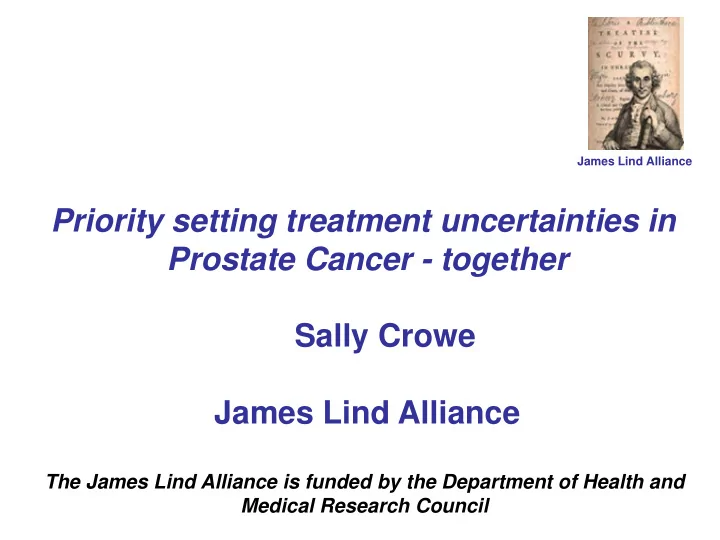

James Lind Alliance Priority setting treatment uncertainties in Prostate Cancer - together Sally Crowe James Lind Alliance The James Lind Alliance is funded by the Department of Health and Medical Research Council
Our starting point………. Do treatment uncertainties considered important by patients and clinicians, influence the clinical research agenda?
Our finishing point………. Shared priorities in treatment uncertainties from clinical and patient perspectives, that leads to potentially useful research.
START The total number of treatment uncertainties in prostate cancer gathered – for example 300 FINISH A ‘top ten’ prostate cancer treatment uncertainties, that are considered the most important by all involved in the process
Uncertainties from patients, carers, professionals, research literature Consultation and collation of uncertainties Uncertainties refined: e.g. ineligible excluded, uncertainties re-written (PICO), duplicates combined Entered into DUETs
Share Prostate Cancer treatment uncertainties (DUETs) with partner organisations (JLA affiliated etc) Each asked to choose their top ten uncertainties – share with they achieved their top ten Each submission scored 1 to 10 selections allocated 10 to 1 points Other factors that could be taken into account Uncertainties which are: submitted independently more than once - freqency submission by multiple organisations – shared and/or submitted by both patients and clinicians
Final priority setting Final short list circulated to priority setting workshop participants for individual selection of top ten prior to workshop. Workshop consists of four rounds of discussion in mixed groups
Considering and sharing their own choices (Round 1) in small groups Agreeing a short list of ten and rank order the rest (Round 2) in small groups Aggregating results from all small groups = ‘first top ten’ + ranked list New groups consider aggregate top ten (Round 3) aggregate results again
Final whole group discussion of aggregate top ten – final chance for changes (Round 4) End result = ten prioritised areas of treatment uncertainties worthy of further research
Likely research needs Prioritised uncertainties • Development of system for classifying ‘intensity’ of What are the optimal pelvic floor pelvic floor muscle training programmes • Systematic review to assess the effectiveness of muscle training protocols (frequency and duration of programmes of increasing intensity • Modelling with economic evaluation of cost- therapy) for the treatment of different patterns of urinary effectiveness of programmes of increasing intensity • [Subsequent primary studies may be needed] incontinence? • Systematic review of GP-based interventions (such Can guidance or training for general practitioners on as guidelines, and continuing professional appropriate pathways of care development) aimed at increasing the quality of care of improve the management of patients with urinary incontinence • [Subsequent primary data collection studies likely to patients with urinary incontinence? be needed.] • Systematic review of interventions for incontinence What is best practice for the where the patient group have a combination of stress and urgency incontinence. treatment of combined stress • [Subsequent primary data collection studies likely to urinary incontinence and detrusor over activity? be needed.]
• [Updated systematic reviews] What catheter regimens are • Randomised trials in patient with neurogenic bladder most effective in preventing urinary tract infections in patients dysfunction using intermittent self-catheterisation to using intermittent self- evaluate: alternative catheter regimens; and antibiotic catheterisation for the prophylaxis vs. no antibiotic prophylaxis. management of a neurogenic bladder?/What is the effectiveness and safety of prophylactic versus symptomatic antibiotic therapy in patients with neurogenic bladder dysfunction using intermittent self- catheterisation • New systematic review Which treatment is most effective for the reduction of urinary frequency and urgency? • Pre-trial economic modelling Is urodynamic testing prior to • Pragmatic randomised controlled trial surgery for urinary incontinence associated with better continence rates and quality of life, than surgery indicated without such testing?
• New systematic review What is best practice for the • [[Subsequent primary data collection studies likely to management of stress urinary incontinence following failed be needed.] tension free vaginal tape surgery? • Updated systematic review What are the most effective • [Subsequent primary data collection studies likely to treatments of daytime urinary incontinence in children? be needed.] • [Updated systematic review] Are disposable catheters more • Pragmatic randomised controlled trial comparing or less acceptable than reusable catheters, in terms of effective disposable (single use) catheters with reusable catheters bladder management, patient experience and urinary tract infections? • Pragmatic randomised controlled trial In women with prolapse (symptomatic or asymptomatic) and stress urinary incontinence, should suburethral tapes be inserted at the same time as repairing the prolapse?
Learning from previous priority setting partnerships, and from the literature Data used for priority setting purposes must be checked for true uncertainty first Experience tells us that it is vital that groups stick to rules, e.g. no clumping of uncertainties People/groups will feel strongly about ‘their uncertainties’ – however the process will make people talk and compromise if needed Uncertainties identified will probably range from very specific clinical or surgical issues to broad service delivery issues, this presents challenges for priority setting The balance of patients and clinicians participating in the process is likely to have an important bearing on the outcome of the process, especially the final prioritisation meeting, so plan for attrition of participants!
Recommend
More recommend